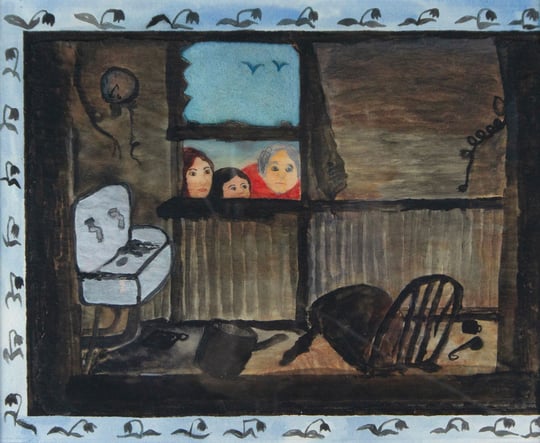
I had a chance to meet up with my friend and former roommate S. Patricia Patterson earlier this month at her home and studio space in Pine Lake, Georgia. “Tricia” as her friends call her, lives there with her boyfriend Adam Saunders and their jovial baby boy, Levi. Tricia creates large-scale paintings full of bold patterning, subtle applications of watercolor, and skewed memories. We got to chat about her time at grad school in San Francisco, family secrets, and her current show at Beep Beep Gallery (through September 6).
Sherri Caudell: What was your experience like attending graduate school at the San Francisco Art Institute?
S. Patricia Patterson: I applied to six places. San Francisco was my top choice. It was a good experience. I was there for painting and printmaking, and I was the assistant to the head of the printmaking department. Living there was amazing at first, but it could also be frustrating because it’s just so expensive. I didn’t take out all the loans that I could have, so I had to work. I was a nanny and had babysitting jobs all over the city. I lived in the Upper Haight.
SC: What were some of your favorite things about working in the program?
SPP: I really liked working with the artists Matt Borruso and Josephine Taylor. They were a big influence on my work. Matt does big oil paintings of children that are kind of carnival looking and a bit freaky. Some of his work is about coming of age, adolescence, and feeling like you are not accepted.
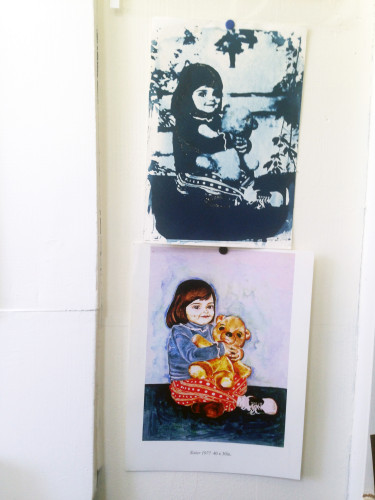
SC: What is the most important thing you learned at graduate school?
SPP: How to defend my work and talk about it in a different way. I did little abstract paintings before, but I didn’t really start painting until the year that I was graduating from Georgia State University. I was doing a lot of printmaking there. I took a watercolor class with Teresa Bramlette Reeves. I did three prints of my family members that I distorted a little bit, and then I would paint over them with gouache and watercolor. Teresa was a massive influence on me at the time and mentored me through the process of applying to graduate schools. I knew that painting was what I wanted to do. I applied with six paintings that I had just done and was hopeful that I would learn how to render more. They didn’t really have foundation classes at the Art Institute, so I had to work hard to get to the point where I could achieve what I wanted.
SC: How would you describe your work?
SPP: Visually, I would describe it as a portrait that looks under-painted but when you get close to it, you realize there are a lot of small areas of detail. I focus in on eyes, patterning, the detail in clothing, and things like a reflection on the floor. My work has a dream quality to it and it’s all about childhood memories to me.
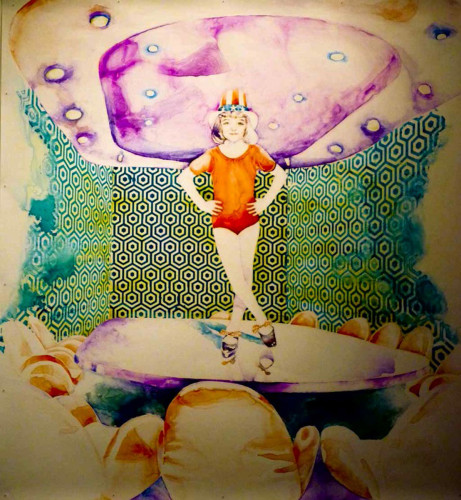
SC: Where do the patterns in your paintings come from?
SPP: I have an archive of patterns on the Internet and a collection of different time period books that I pull from. That’s how I get a lot of my color palettes too. I cut the source material out of construction paper, photograph one area, and then use Photoshop to take that area and multiply it. This turns it into a pattern and then I screen-print it.
SC: What is your process like for choosing the themes in your work?
SPP: I’ll do some research into my family background. I’ve collected photographs from albums I get at flea markets or stuff that I’ve found on the Internet. It’s about the idea of a specific memory for me in relationship to what I conceive of as a general family memory. Like the first time you are in a school play or your first trip to Yellowstone National Park. Things that a lot of people have memories of. I take portions of the found images and skew them with my family. So what I’ll end up with is a more general memory, but it’s also a way of stamping my family onto a different family to some extent. I’ll create a photo collage and I’ll work back and forth from the two sources. I’ll do some distortions in the photo collage and then I’ll start drawing something on Yupo paper. It’s a plastic paper that comes in a 5-foot ream. Before I was working on wood panel, but Yupo allows me to work on a surface that isn’t going to absorb the watercolor. Watercolor takes time to dry and it kind of corrodes. I’ll draw something out with watercolor pencil, and then I’ll mask off my figures and my foreground with wax paper. Once I cut out an outline in wax paper, I’ll screenprint the background in first. So patterning is the first thing that I fix into my paintings, which creates a kind of silhouette for me to react to.
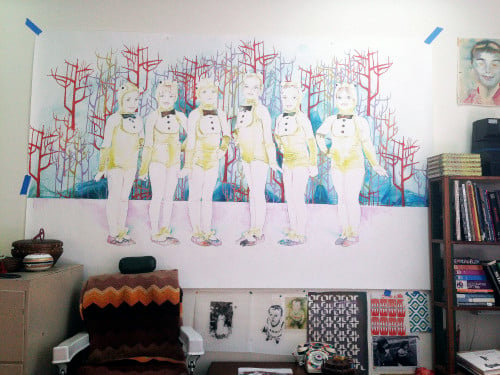
SC: For all of the layering you do, the pieces still possess a very delicate quality.
SPP: They’re not very dense. You have to be very careful with this stuff. It’s unpredictable. Some pigments don’t lay down well on the paper, some do—it’s just trial and error.
SC: How do you balance being a mother with being an artist?
SPP: I’ve yet to see. I think my work will be changing. I have reacted to my childhood memories, and now I’m thinking of what his childhood will be like.
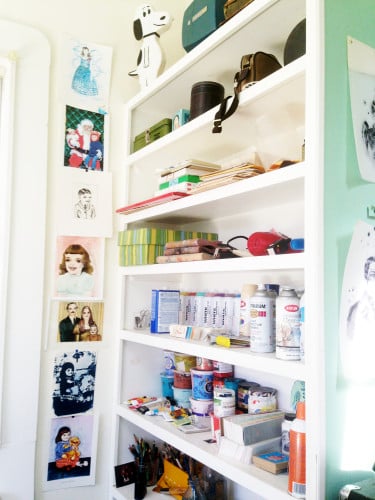
SC: Where do you think your interest in family and memories come from?
SPP: I think my interest in family, memory, and portrait-based memory is a reflection of the strong tie I have to my own family. My great grandfather founded Woodward Academy. I went to school at Woodward, my mother taught there, and my grandfather was the president of the school. I would see these portraits of my ancestors get moved around to different rooms of the school, like the library. Also, relating to that, my mom has all these pictures of Christmas cards of my grandparents and her and her sisters. They looked like the perfect nuclear family at the time. I was brought up to think that they were perfect, and then I got older and realized that they were not that perfect.
SC: Tell me about “Continuum”, the show you have up now at Beep Beep Gallery with artist Sanithna Phansavanh.
SPP: Of the four paintings I have in the show, two are new. They are based on family memories as well. Kathryn Stockett, author of The Help, just bought a piece that is a picture of two little girls (my mom and my aunt) with guns. It’s called I Can Shoot A Partridge With A Single Cartridge, and it’s named after the “Annie Get Your Gun” song “Anything You Can Do I Can Do Better.” That painting is about the rivalry between my mother and one of her sisters. The other new work is named Yellowstone 1986 and was based on my first trip to Yellowstone National Park. The painting is of a buffalo and two children. It’s actually activated in the same way that a totem pole is, where there is a hierarchy. I photographed my niece and nephew for that painting, which I’ve started doing a little bit of, and then I’ll paint from the photograph.
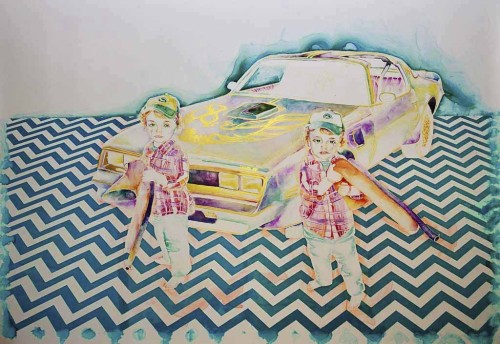
5 by 7 feet.
SC: Had you shown with Beep Beep before?
SPP: I’d shown one piece with them about a year ago. They work very hard. They have their own business, the bar Mother, on the side. They are also working towards building the gallery up more. I’m not represented right now; I would actually really like to be. I am not good at promoting myself. Right now I’m doing commission work that I’ve gotten through working with the Swan Coach House. I moved back here from San Francisco and was contacted by Kelly Teasley, one of the founders of Young Blood Gallery, because I had shown with them before. She asked if I would be interested in them nominating me for a grant, and I said yes. I won the Swan Coach House’s Emerging Artist Award and they gave me money to create a solo show there called “Back to the Future.”
SC: How do you like living a little bit outside of Atlanta, in Pine Lake? Your house is phenomenal.
SPP: With the baby, it’s great. It’s only 12 minutes from Decatur. This neighborhood is really special in that you feel like you’re entering the mountains, it’s very safe, and people leave their doors open. We’ve been here for a year. We moved here a little bit after we found out that I was pregnant. We’re at a very transitional, getting-used-to-being-parents point. Adam Saunders is my boyfriend. He’s a musician who lived in Athens for a little while and went to UGA. We share this space as a music/arts studio.

SC: What has been informing your artwork lately?
SPP: I’m really invested in roadside attractions and folk artists. Places like Pasaquan, Arabia Mountain or Howard Finster’s Paradise Garden. I like the idea of seeking out these things that were once pretty common but get overlooked now. People used to go to these places, like the Flintstones Bedrock City. It’s near the Grand Canyon and it’s an old football field that they converted into a replica of Bedrock City. I like the idea of these sculptures that are made for these spaces that aren’t considered art at all but could be considered folk art.
SC: What are you working on next?
SPP: I’m working on a way to incorporate my new family into portraits, mainly the baby. My memories are about taking care of him in this nurturing way that I’m not used. I have ideas, but I haven’t started working on a new body of work.
SC: What do you enjoy about teaching art?
SPP: I really like teaching kids who aren’t necessarily invested in working with art, but then you start working with them and if you can turn them into someone who is going to be an artist, or think that way, or who is very talented, it’s the most rewarding feeling. I just like sharing ideas. I’m not very extroverted, but I’m a pretty good teacher. It’s almost more rewarding to me sometimes then selling a painting.
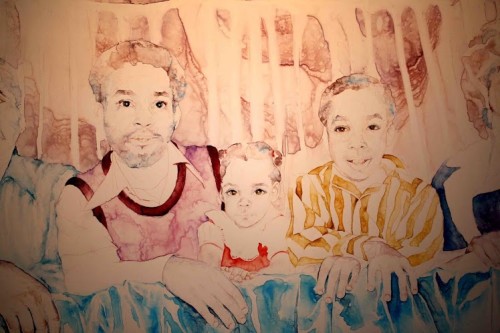
SC: What’s your favorite comment that you’ve gotten about your work?
SPP: I feel like a lot of people say that they are very scared by the work—that there’s something spooky about it. I think that there is something that is intentionally stifling, at times.
SC: How is your version of portraiture off-kilter?

SPP: Hopefully it conveys that there is something going on psychologically and people become more invested in the work, rather than just looking at it and then quickly looking away.
SC: Why did you choose the medium of watercolor? The marbling quality of the watercolor mixed with your use of negative space allows the work to have a very airy and ethereal effect.
SPP: I wanted something that could look corrosive, but could look beautiful and delicate at the same time. Watercolor is all of those things. It’s actually hard to paint with, and it’s not very forgiving. It takes a long time to dry and it reticulates out. You can see ripple marks and rings. It’s difficult to control watercolor. My skill has gotten pretty good and I’m usually able to anticipate what’s going to happen.
Sherri Caudell, a poet and writer from Atlanta, is the poetry editor of Loose Change magazine, published by WonderRoot.


